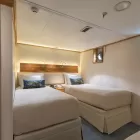This morning, visit Vicente Roca Point, a high peak of land created out of remains of a tuff cone, with two protected turquoise coves on both sides. One of them, the Bolivar Channel is one of the richest marine ecosystems on Earth. This place is only accessible by water, with great opportunities for deep-water snorkeling. In this part of the Galapagos, the upwelling of cold water currents from the west, offer an abundant plankton supply for marine species like red-lipped batfish, seahorses, frogfish, nudibranchs, octopus, and the mola-mola or sunfish. It is common to observe dolphin pods, sea lions rafts, and tuna banks. The dinghy ride along the coast allows observing a great diversity of seabirds like noddies, brown pelicans, Galapagos penguins, flightless cormorants, Nazca and blue-footed boobies are often seen feeding all at once during the cold season (May – December). Whale watching is also common while navigating.
In the afternoon visit Espinosa Point, on Fernandina Island, an area that boasts some of the highest diversity of endemic sea fauna in the Galapagos. Here, the largest, most primitive-looking marine iguanas are found mingling with sea lions and Sally lightfoot crabs. Fernandina displays a wonderful opportunity to encounter flightless cormorants at their nesting sites, Galapagos penguins and the “King” of predators on the islands, the Galapagos hawk. Pa-hoe-hoe and AA lava formations cover the majority of Fernandina terrain. Vegetation is scarce inland, with few brachycereus cacti and in the shore mangrove can be found.




















